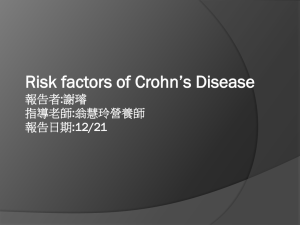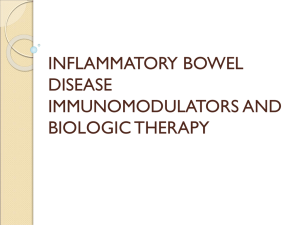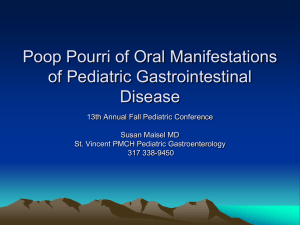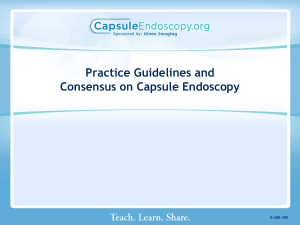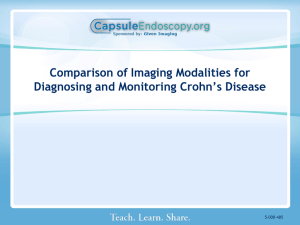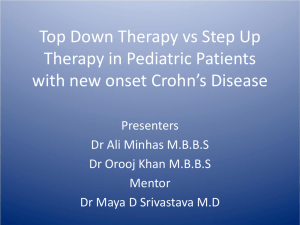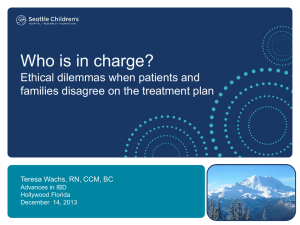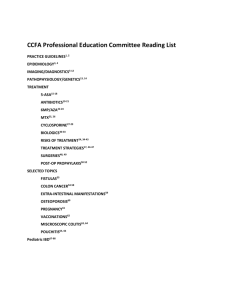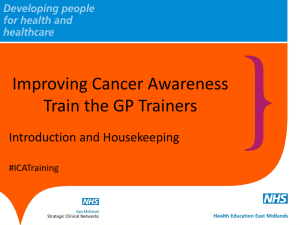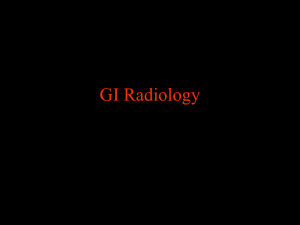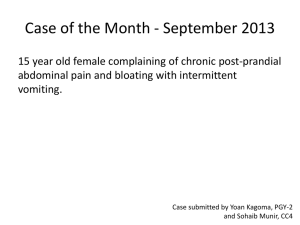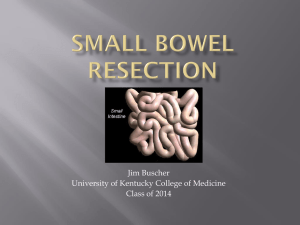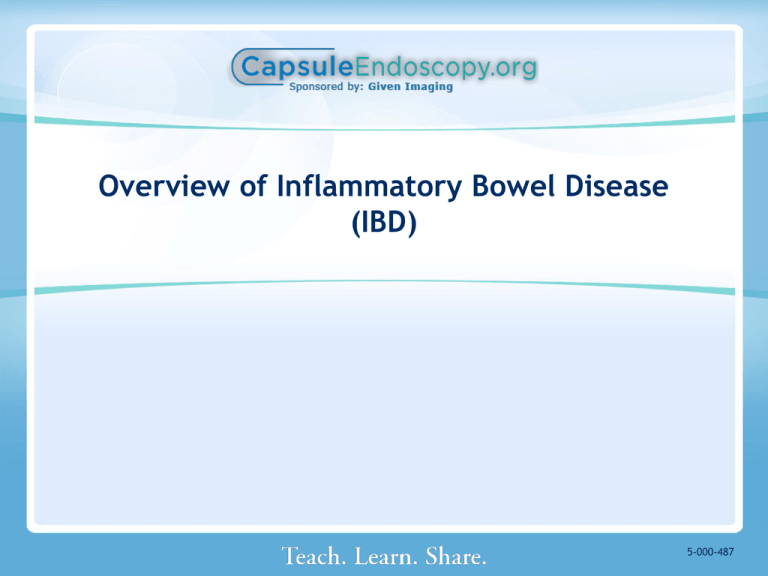
Overview of Inflammatory Bowel Disease
(IBD)
5-000-487
Inflammatory Bowel Disease
• Group of chronic inflammatory diseases of the GI
tract
• Main subtypes are
• Ulcerative Colitis (UC) - involves the large intestine (colon)
and rectum
• Crohn’s Disease (CD) - may involve the entire GI tract
• Indeterminate Colitis (IC) - indeterminate
Crohn’s & Colitis Foundation of America. http://www.ccfa.org/info/about/.
Ulcerative Colitis and Crohn’s Disease: Distinct
Diseases With Similar Symptoms
Ulcerative Colitis
UC
Crohn’s Disease
CD
Stricture
Healthy bowel
Healthy
bowel
Inflammation
Inflammation
Terminal ileum
Patchy
inflammation
Ulcers
Crohn’s & Colitis Foundation of America Web site. http://www.ccfa.org/info/about/.
Friedman S et al. In: Fauci AS, et al, eds. Harrison’s Principles of Internal Medicine.
17th ed. Columbus, OH: McGraw-Hill; 2008:1886-1898.
Crohn’s Disease
• CD and UC have many overlapping features and
several distinctive differences
• In a considerable number of patients, diagnosis may change
during follow-up
• CD has transmural and segmental inflammation
patterns and has the potential to involve any part of
the GI tract, including the peri-anal area
• CD has a tendency to be complicated by fistulae,
abscesses, and strictures
• CD has a lower propensity to develop into colorectal
malignancy
Lichtenstein GR. The Clinician’s Guide to Inflammatory Bowel Disease.
Thorofare, NJ: Slack Publications; 2003:16-17.
Crohn’s Disease
(continued)
• CD has a unique pattern of mucosal involvement
• Early stages develop aphthous ulcers
• As the disease progresses, these superficial ulcers enlarge
and combine to become long and linear
• Larger ulcers can deepen throughout the bowel wall—possibly
complicated with fistula and abscess formation
• Longitudinal and transverse linear ulcers can cross over
normal, non-ulcerated mucosa to form a cobblestone
appearance
• Transmural inflammation can heal, forming scars that lead to
strictures
Ulcerative Colitis
• UC is a relapsing and remitting disease
• Almost every patient with UC has diarrhea, often
with blood and mucus
• Anal lesions, fever, and weight loss are less frequent
in UC than in CD, and there are rarely symptoms of
obstruction
• General markers of inflammation (erythrocyte
sedimentation rate and C-reactive protein) are less
frequently found to be elevated in UC and rise to a
lesser extent than in CD
• UC extends continuously from distal to proximal and
almost always involves the rectum
Satsangi J, Sutherland LR, eds. Inflammatory Bowel Disease. New
York, NY: Churchill Livingstone; 2003.
Indeterminate Colitis
• No definitive diagnostic criteria for IC
• A diagnosis of IC is made when the criteria for either UC or CD cannot
be definitively established on the basis of endoscopy or histologic and
radiologic findings
• 10%-15% of cases diagnosed as IC at initial evaluation
• >50% will be diagnosed as UC or CD over time—majority as UC
• 4%-5% of all IBD will be left with a diagnosis of IC, with
an uncertain treatment course
• More severe course with greater chance of colectomy and pouch
failure
• Optimal treatment regimen is unknown
• Current evidence supports the premise that IC may be
a separate entity; however, more studies are needed
Burakoff R. J Clin Gastroenterol. 2004;38 (5 suppl):S41-S43.
Pediatric Considerations
• Diagnosis of CD in pediatric patients can be difficult
with conventional modalities1
• Distinguishing between UC and CD is difficult with colonoscopy
with ileoscopy (C+I) alone because of lack of definitive lesions2
• Pediatric patients more likely than adult patients to have
disease involving the proximal small-bowel3
• FDA-cleared diagnostic tool for children ≥ 2 years of
age4
• Main indications: Obscure GI bleeding and suspected
CD4
1. Seidman et al. Techniques in Gastrointestinal Endoscopy. 2006;8:149-153.
2. Castellaneta SP et al. J Pediatr Gastroenterol Nutr. 2004;39(3):257-261.
3. Cuffari C. Minerva Pediatr. 2006;58(2):139-157.
4. Shamir R et al. World J Gastroenterol. 2008;14(26):4152-4155.
Pediatric Considerations
(continued)
• Pediatric studies report that the extent of small bowel involvement
was better delineated by CE than by small bowel follow-through, CT
scan, or standard upper endoscopy1
• Capsule endoscopy led to reclassification of disease (UC/IC to CD) in
5 of 7 (71%) patients studied1
• 13 of 21 (62%) patients with CD had more extensive small bowel
involvement1
• CE findings led to reclassification of disease (UC/IC to CD) in 5 of 7
patients (71.4%)1
• Resulted in change in medical management for all 5 patients
• Procedure is free of anesthesia and is non-invasive, patient-friendly,
safe, and well-tolerated
• Main limitation is swallowing large capsule2
• Capsule can be introduced to the duodenum via standard endoscopy
• Main adverse event is capsule retention due to strictures2
1. Cohen SA et al. J Pediatric Gastroenterol Nutr. 2008;47(1):31-36.
2. Shamir R et al. World J Gastroenterol. 2008;14(26):4152-4155.
Pediatric Considerations
(continued)
• CE was undertaken in 20 children with suspected Crohn’s
disease; age range of 5.0 – 7.9 years
• 11/20 (55%) had positive findings consistent with IBD; 8
had small bowel Crohn’s disease and 3 had Crohn’s colitis
• Upper and lower endoscopy failed to provide a diagnosis
in these children
• The finings in the 11 positive studies varied from diffuse
aphthous ulcerations throughout the small bowel to
fissuring with terminal ileus
• All 11 had evidence of acute active disease
• 9/20 (45%) had normal studies
• This study demonstrates that CE is useful and equally as
safe in young children as it is in adults
Fritscher-Ravens et al. Gut 2009;58(11):1467-1472.
Cost and Burden of Care in Crohn’s Disease
• Hospitalization, surgery, work loss, and impaired quality of life
contribute to the cost and burden of care1
• Major determinants of cost are inpatient hospitalization/surgery (>50%),
outpatient services, physician visits, and prescription medications2
• Aggregate global costs for the first year are ~$8,295 for newly diagnosed
patients who are medically managed; for those requiring aggressive
medical management, including anti-TNF therapy, the cost is $29,508;
and for patients requiring hospitalization, the cost is $49,0743
• Diagnostic costs for CD can be considerable, especially given the
cycle of repeat testing due to low diagnostic yield of certain
modalities and the inability of current diagnostic procedures to
image the entire small bowel4
1.
2.
3.
4.
Lichtenstein GR et al. Am J Gastroenterol. 2004;99(1):91-96.
Feagan BG et al. Am J Gastroenterol. 2000;95(8):1955-1960.
Leighton JA et al. Gastroenterology. 2009;136(suppl 1): Abstract W1084.
Goldfarb NI et al. Dis Manag. 2004;7(4):292-304.
Managing the Relapse of Crohn’s Disease
• CE is helpful in patients following ileocolonic resection for Crohn’s
Disease (CD) to monitor the recurrence of active disease1
• Crohn’s disease typically recurs at the site of removal of
macroscopic lesions and extends to the neoterminal ileum following
the same initial pattern1
• In a study of 30 patients with post operative recurrence of Crohn’s
disease, Involvement of the small intestine occurred in 21/30 (70%)
of patients operated on less than 6 months before1
• CE is shown to be a useful tool for detecting CD recurrence and
previously undetected small bowel involvement2
• CE exploration is of great use in the evaluation and treatment
management of recurrent CD2
1. Bourreille A et al. Gut 2006;55(7):978-983
2. Pons Beltran V et al. Gastrointest Endosc 2007;66:533-40
Therapeutic Goal: Remission
• In a study by Lichtenstein et al., Crohn’s Disease
Activity Index (CDAI) remission was associated with
reduced hospitalization and surgeries, increased
employment, and normalized quality of life1
• 573 patients with moderate to severe Crohn’s disease were
studied at week 54, after infliximab was administered, to
determine the long term efficacy and safety of the therapy
• Patients in remission at week 54 were employed, and had
better mental and physical functioning than those not in
remission
• Hospitalization and surgery rates decreased as the
percentage of time patients were in CDAI remission increased
1. Lichtenstein GR et al. Am J Gastroenterol. 2004;99(1):91-96.
Therapeutic Goal: Remission
• Current body of evidence supports the use of mucosal
healing as an objective biological parameter of shortterm efficacy in CD1
• Clinical improvement with infliximab correlates with
improvement in the endoscopic severity index
• Systematic 8 week maintenance treatment with infliximab
induces mucosal healing, as long as the therapy is continued
• This body of evidence supporting
the use of mucosal healing as an
objective biological parameter of
short-term efficacy in CD is
sufficient to consider endoscopy
as an essential component of
clinical trial outcomes
1. Van Assche G et al. Tech Gastrointest Endosc. 2004;6:138-143.
Crohn’s Disease and Small Bowel Evaluation
• CD is a debilitating, progressive, inflammatory disease for which
there is no cure
• CD most commonly affects the ileum in 70% of patients, with up to
30% of patients presenting with disease limited to the small bowel1
• Complete assessment of the small bowel is necessary
• Comprehensive evaluation of the entire small bowel—not just the
colon and ileum—is needed to:
• Make a definitive diagnosis of CD
• Determine extent and severity of disease
• Determine baseline (disease activity) to serve as a comparator for
monitoring and surveillance of disease
• Colonoscopy at the terminal ileum can miss CD located proximally to
the ileum
• Patchy pattern of diseased and normal bowel may increase the potential
of missing diseased areas during C+I
1. Lashner BA. Clinical features, laboratory findings, and course of Crohn’s disease. In: Kirsner
JB, ed. Inflammatory Bowel Disease. 5th ed. Philadelphia, PA: Saunders; 2000:305-314.
Is Location of Disease Important?
• In 70% of Crohn’s disease patients,
the small bowel is involved
• In the right colon, another 15% of
CD is identified
• In the descending and transverse
colon, 15% of CD is identified
• CD can occur in patchy patterns diseased areas followed by normal
areas
• Colonoscopy at the terminal ileum can
miss Crohn’s located proximally to the
ileum
40%
30%
Engstrom et al. “Diagnosis and Management of Bowel Diseases” Prof. Communications Publisher 1999.
30%
Small Bowel Involvement in Crohn’s Disease
• A prospective study by Voderholzer et. al. showed that
small intestinal involvement in CD occurs more
frequently than previously considered1
• CE showed significantly more findings in the small
bowel (jejunal and ileocecal involvement) than CTE
(61% CE vs. 32% CTE)1
• The results of CE provided explanations for the
symptoms of patients and gave a rationale
for the therapeutic decision1
1. Voderholzer WA et al. Gut. 2005;54(3):369-373.
Small Bowel Involvement in Crohn’s Disease (continued)
Frequency of lesions (n) in patients who underwent CE
Small Bowel
Segment
Examination
(n)
Patients With
Small Lesions
Patients With
Large Lesions
Upper GI tract
OGD (41)
CE (41)
17
14
0
0
Small
intestine
CTE (41)
CE (41)
10
23
5
8
Neoterminal
ileum
C+I (40)
CTE (41)
CE (32)
23
14
24
13
13
10
OGD = oesophagogastroduodenoscopy;
CE = capsule endoscopy;
CTE = computed tomography enteroclysis;
C+I = colonoscopy with ileoscopy.
Voderholzer WA et al. Gut. 2005;54(3):369-373.
Importance of Small Bowel Evaluation
in Crohn’s Disease
• Comprehensive evaluation of the entire small bowel —
not just the colon and ileum — is needed to:
• Make a definitive diagnosis of CD
• Determine extent and severity of disease
• Determine baseline (disease activity) to serve as a comparator
for monitoring of disease
• Colonoscopy at the terminal ileum can miss CD located
proximally to the ileum
• Patchy pattern of diseased and normal bowel may increase the
potential of missing diseased areas during C+I

